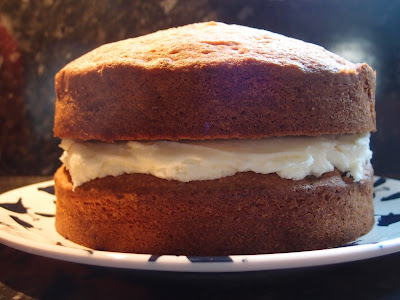Whenever Mr CC and I are in York there are two things I have
to eat: Firstly, a Fat Rascal from
Bettys, and secondly, a Yorkshire
Curd tart from Bennett’s – a lovely
little café right next to York Minster.
Admittedly, the curd tart has a slight lemon tang but I’m warming
towards lemon – I’m not saying we’re ever going to best friends but the
animosity and hurt is over.
I’ve long wanted to make a curd tart but it’s nigh on
impossible to find curd cheese unless you are blessed with a great deli, a
fancy supermarket or farm shop. Some
recipes say you can substitute ricotta but – whisper it for fear of causing offence – I’ve come to the
conclusion that I don’t like ricotta.
Neither the texture nor the blandness do anything for me in baked goods
(it’s ok in savoury recipes).
This recipe, adapted from the BBC GoodFood website, starts with instructions how to make curd cheese and it’s a lot simpler than you might think. Start with a very high fat, rich milk:
The formation of the curds in the milk is like witchcraft; I felt like I was at a cauldron making magic happen:
The most fascinating thing is that the curds suck the fat out of the milk so, as they form, the remaining liquid turns more and more watery. Really one of the most oddly enjoyable things I’ve done for a long time! I had no use for the whey, but apparently you can keep it and use it wherever you would use buttermilk….thinking about it, it probably is buttermilk?
The only real thing to be aware of is that you need to start it the day before to allow draining time. A lot of draining time….I started it off in a tea towel lined colander sitting in the sink….
… and then, after several hours, stood the colander (still tea towel lined) in a bowl….
….before refrigerating it overnight. The next morning I had this:
This tart is perfect for anyone who doesn’t like overly sweet bakes; it has a sharp zing to it from a combination of the lemon and curd cheese. One slice will not be enough!
Ingredients
For the
curds:
1.8 litres full fat Jersey milk – this has 5g fat per 100ml (compared to semi skimmed which has 1.8g per 100ml)
Juice of 1 ½ lemons
(NB. This made 445g curd cheese – so if you have curd cheese to hand and don’t want to make it, use this weight)
1.8 litres full fat Jersey milk – this has 5g fat per 100ml (compared to semi skimmed which has 1.8g per 100ml)
Juice of 1 ½ lemons
(NB. This made 445g curd cheese – so if you have curd cheese to hand and don’t want to make it, use this weight)
For the
pastry:
210g plain flour
130g unsalted butter – cold
2 teaspoons caster sugar
1-2 tablespoons cold water
210g plain flour
130g unsalted butter – cold
2 teaspoons caster sugar
1-2 tablespoons cold water
For the
filling:
75g unsalted butter – at room temperature
75g caster sugar
2 eggs
100g currants
Grated nutmeg – allspice is more traditional, if you prefer
75g unsalted butter – at room temperature
75g caster sugar
2 eggs
100g currants
Grated nutmeg – allspice is more traditional, if you prefer
Method
Start making the curds the day before you want to serve the tart:
place the milk in a saucepan and bring to a simmer.
Add the lemon juice and turn the heat to low.
Gently stir while the curds form; if you are too firm you will
break the curds. The curds form very
quickly – mine were smaller than I expected (but I had nothing to compare it
to, so that probably doesn’t mean much).
Once the mixture looks watery with creamy lumps remove from
the heat and leave to cool.
Drain the curds overnight in the fridge. I lined a colander with a clean tea towel and
suspended this across a bowl. I started the draining process in the sink
because there was a lot of liquid and I didn’t need it for anything.
On the day of making the tart start with the pastry: place the
flour, butter and sugar in a food processor and blitz until you have breadcrumb
sized pieces.
Add the water gradually and only what is needed to form a
dough.
Tip the dough out onto a sheet of clingfilm and handle just
enough to bring together.
Flatten into a disc and wrap in clingfilm.
Refrigerate for 20 minutes, although the dough will happily
sit in the fridge for a couple of days.
Preheat the oven to 180C/fan oven 160C/350F/gas mark 4.
Roll out the pastry and use to line a 23cm loose bottomed tart
tin. Leave the excess pastry overhanging
the tin.
To make the filling beat together the butter and sugar until
soft and well combined.
Beat in the eggs, one at a time.
Stir in the curds, making sure you break up any large lumps.
Stir in the currants.
Spoon into the pastry case (note – no need to blind bake the
pastry) and level the surface.
Grate some nutmeg over the top, or sprinkle over some ground
allspice.
Bake for approximately 40 minutes or until the tart feels set
and the pastry is golden.
Leave to cool in the tin.
Serve in generous slices.
Bask in the glory of the wonderful thing you have created.
Eat.
























